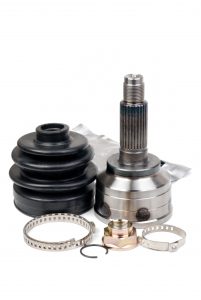What is a CV Joint and Boot?
CV joints, short for constant velocity joints, are like flexible connectors in your car. They help the engine’s power move to the wheels smoothly, even when you’re turning or going over bumps. Cars with front-wheel drive or all-wheel drive have these cool joints in their drivetrains.
Taking care of your CV joint:
- Check the Boots: Your CV joints wear special protective boots. Check them for cracks or damage regularly. If they’re damaged, dirt and water can get in, causing problems.
- Grease It Up: These joints need some special grease to stay smooth. Check and add grease as recommended by your car’s maker.
- Listen for Weird Sounds: If your car starts making strange sounds or vibrating, it might be your CV joints acting up. Get it checked out to avoid bigger problems.
Signs of CV joint needing replacement:
- Clicking or Popping Noises: One of the most common signs of a failing CV joint is a clicking or popping noise, particularly when you’re turning. This noise is typically more noticeable when making tight turns at slow speeds. It may indicate worn-out or damaged CV joint bearings.
- Knocking Sounds: A knocking sound when driving, especially during acceleration or deceleration, can be a sign of a damaged or failing CV joint. The knocking noise may get louder as the joint wears out further.
- Vibration or Shaking: If you feel excessive vibration or shaking, particularly while accelerating, it could be a sign of an imbalanced or damaged CV joint. The vibration may be more noticeable at higher speeds.
- Leaking grease from CV boot: Inspect the CV joint boots for any signs of grease leakage. If you see grease on the inside or outside of the boots, it could mean that the protective boot has been damaged, allowing contaminants to enter and damage the joint.
- Torn or Damaged Boots: The protective rubber boots covering the CV joints are crucial for keeping out dirt and moisture. If you notice any tears, cracks, or visible damage to these boots, it’s a sign that they need attention. Damaged boots can lead to premature CV joint failure.
- Difficulty Steering: A damaged CV joint can affect the steering performance of the vehicle. If you experience difficulty steering, especially during turns, it could be due to a failing CV joint.
Can you drive safely with a damaged CV joint?
Although driving with a damaged CV joint is still possible, we recommend for your safety that you have the part replaced as soon as possible.
Beware of reduced steering control:
CV joint problems can lead to difficulty steering. This can lead to reduced control of your vehicle and increased risk of accidents occurring.
Beware of total failure:
If a CV joint is severely damaged, it can fail completely. A failed CV joint can cause the axle to disconnect from the wheel, leading to a loss of power to the affected wheel. This sudden loss of power can be dangerous, especially when driving at high speeds or in heavy traffic.
Be aware of potential damage to other components:
Ignoring a damaged CV joint can lead to additional problems. As the joint deteriorates further, it can damage other components in the drivetrain, such as the transmission or differential. This can result in much more expensive repairs. Getting the joint repaired quickly acts as preventative maintenance, saving you lots of money.
Where is the CV joint located?
The exact location of the CV joint depends on your vehicle’s drivetrain configuration:
- Front-Wheel Drive (FWD): In FWD vehicles, the CV joints are typically located on the front axle shafts. There are two CV joints on each axle—one near the transmission end and another near the wheel end. These joints allow the front wheels to receive power from the transmission while also enabling them to turn and move independently.
- Rear-Wheel Drive (RWD): In RWD vehicles, the CV joints are not commonly found on the drive shafts. Instead, universal joints (U-joints) or a Cardan joint may be used to transmit power from the transmission to the rear wheels.
- All-Wheel Drive (AWD) or Four-Wheel Drive (4WD): AWD and 4WD vehicles have CV joints on both the front and rear drive shafts. This configuration allows power to be sent to all four wheels. Like in FWD vehicles, there are typically two CV joints on each axle—near the transmission and wheel ends.
CV Joint Replacement Service in Hamilton
Our qualified, experienced and trusted mechanics can quickly and easily resolve all CV joint and boot issues for you. This includes inspecting or replacing components in your CV assembly. Call our Hamilton office today to book your vehicle in.
Conveniently located in Fairfield, Grimmer Motors have been providing quality service to Hamilton since the company was established in 1934. When you receive services through Grimmer Motors, you can trust our fully qualified mechanics to safely and efficiently service your vehicle, advising you before further repair work is conducted.
Live/work in any of the following areas? Grimmer Motors could be extra convenient for you.Fairfield
- Fairview Downs
- Enderly
- Claudelands
- Peachgrove
- Hamilton East
- Chartwell
- Chedworth
- Central Hamilton
- Forest Lake, Beerescourt
- Frankton
- Melville
- Waikato

